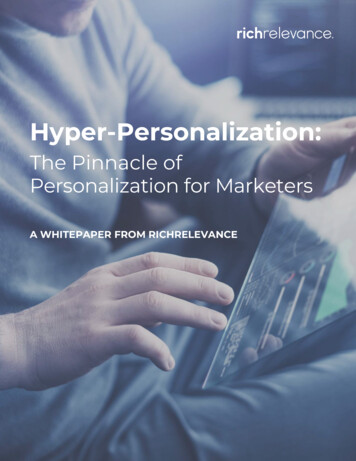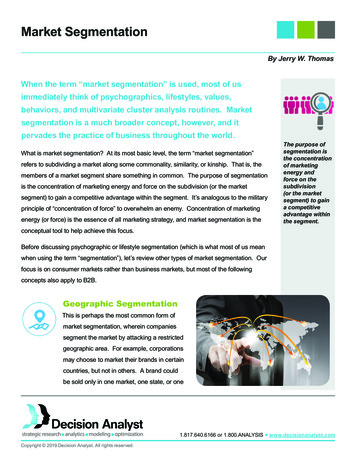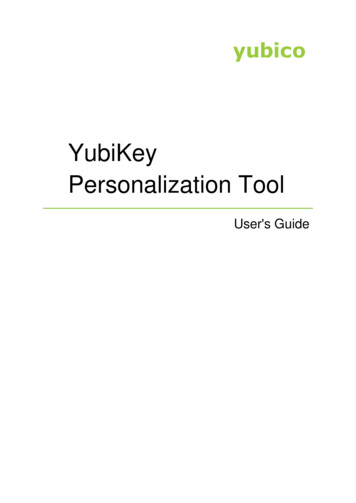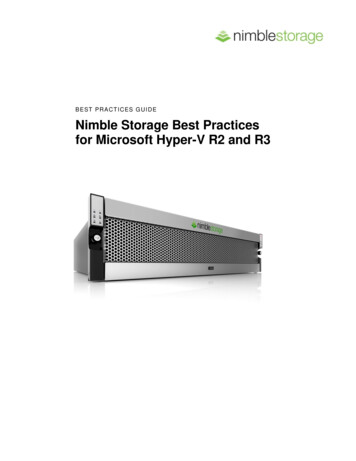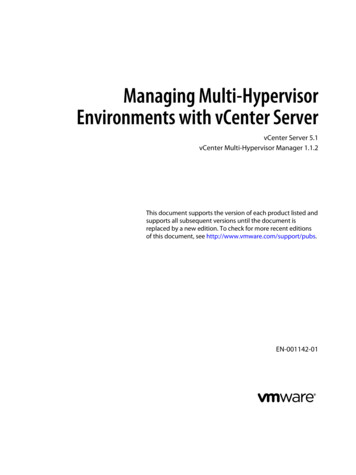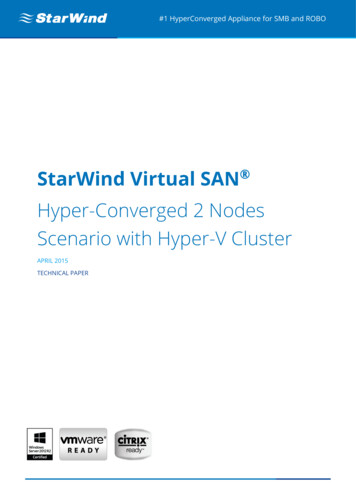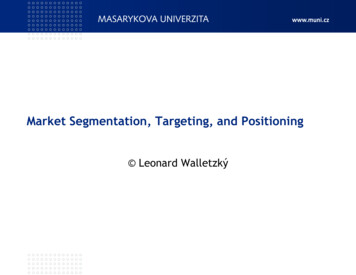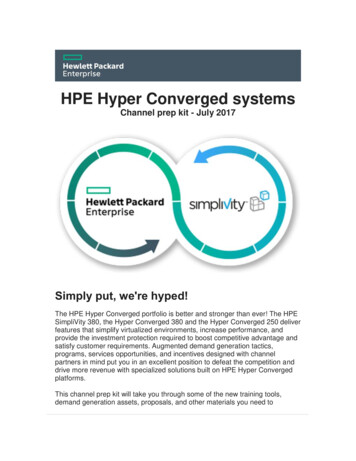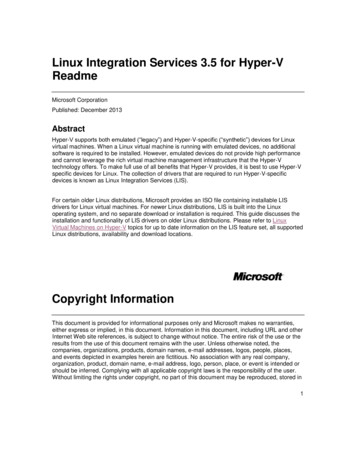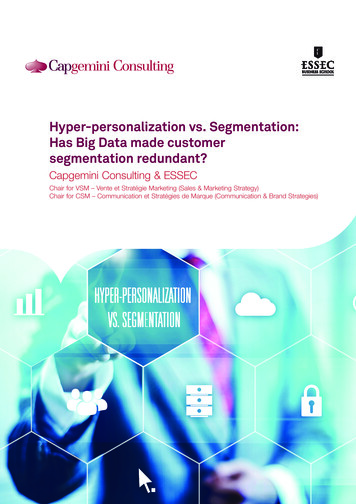
Transcription
Hyper-personalization vs. Segmentation:Has Big Data made customersegmentation redundant?Capgemini Consulting & ESSECChair for VSM – Vente et Stratégie Marketing (Sales & Marketing Strategy)Chair for CSM – Communication et Stratégies de Marque (Communication & Brand Strategies)
Foreword1. Evolution of segmentation techniques: from mass segmentation tohyper-personalization2. Evolving customer behaviors call for a shift in segmentation: we can nolonger segment as we did before3. New technologies can make hyper-personalization a reality4. Limitations of hyper-personalization and challenges regarding itsperceived valueA renewed collaboration between the ESSEC Business School & Capgemini ConsultingThe year 2016 marks the comeback of joint publications between Capgemini Consulting and the ESSEC Business School, inparticular the Chair for VSM – Vente et Stratégie Marketing (Sales & Marketing Strategy), joined this year by the Chair forCSM – Communication et Stratégies de Marque (Communication & Brand Strategies).Since its inception, the objective of the VSM Chair has been to provide training and education in the areas of sales and marketing,while the focus of the CSM Chair has been on communication. The two chairs have started working closely together given the everincreasing overlap between these two functions. Thus, through the programs run by these two chairs, students and the academicteam that mentors them are looking to understand and forecast the strategic trends of the marketing, sales and communicationsprofessions, within various business sectors and environments.Notably, Capgemini Consulting has been supporting students from both these chairs for a few years now, either through long-termmentoring on consulting engagements that the students are assigned to for partner companies, or by organizing conferences thatenable collaboration and the drafting of POVs on future trends.Since the publication of the first ESSEC - Capgemini Consulting Point of View (POV) in 2005 regarding Pricing Strategies, we havebeen addressing key problem areas of businesses, from a forward-looking perspective. Continuing with this tradition, the 2016POV on hyper-personalization dwells upon the relevance of customer segmentation at a time when big data and the associatedtechnologies enable marketers to directly target customers at an individual and personalized level.2
Why and how was ‘hyper-personalization’ selected as a topic?The topic of discussing segmentation and hyper-personalization was chosen after the first ESSEC students’ conference organizedin March 2016. During the event, after the introduction by the sociologist Dominique Desjeux and Nicolas Mariotte, Principal atCapgemini Consulting, the following four keytopics were presented to the audience:-- New marketing models centered on customer engagement,-- An End-to-End digital experience,-- The overlapping of business functions in the digital era and the role of Chief Digital Officers,-- Hyper-personalization vs. Segmentation in the age of Big DataThe conference participants voted for hyper-personalization to be explored further during the upcoming conference, which wasto be held in June 2016. This conference had experts from various domains such as Florence Benoit-Moreau, Lecturer, ParisDauphine University, Corentin Thumerelle, Founder & CEO, Emoovio start-up, Marielle Attal Taieb, Strategic Planning Director,Kellogg’s, and Olivier Auliard, Chief Data Scientist, Capgemini Consulting.The second conference showed great results in terms of addressing many questions concerning hyper-personalization, mainly witha B2C focus, and brought out new challenges on the potential consequences of this new concept. The inputs, ideas and thoughtsgathered during this conference were later leveraged to enrich the content of this Point of View.Hyper-personalization: what is at stake?The concept of segmentation is undergoing a massive transformation. Taking into account new criteria – specifically, behavioral data –businesses can now get a clearer understanding of how different customers or prospects can be, as far as their consumption habits areconcerned. Moreover, new technologies have enabled companies to collect and analyze data at a larger scale to identify and characterizespecific individuals. As they optimize their techniques for gathering customer knowledge, companies can now directly get in touch with aspecific customer and offer him/her not only a tailor-made product/service, but also a personalized experience: thereby delivering a hyperpersonalized and hyper-contextualized experience.Challenges related to hyper-personalization are two-fold: first, it is about fulfilling the customer’s demand for individual and unique recognition(not being part of a generic segment as they consider themselves to be special / unique) and receiving personalized attention as well ascustomized offerings that are adapted to their own specific needs. Second, hyper-personalization requires companies to refine their targetingstrategy in order to optimize their marketing and communication investments.Hyper-personalization as a concept reflects the paradigm shift in the field of marketing, which was previously product-centric, but has nowbecome more customer-focused. Naturally, companies need to better understand who their customers are and what exactly do they want.Traditional segmentation techniques are thus not effective enough to enable organizations to offer personalized solutions at a time when BigData has been enabling them to know and understand their customers individually and fulfill their expectations in a personalized manner.Thus, what is the benefit of continuing customer segmentation in the traditional way when technology has paved the way for individualtargeting and hyper-personalization of customer experiences and offerings?Considering our research and the insights of experts who attended the conference held in June 2016, we must put things into perspectiveand provide a nuanced answer with respect to “abandoning” traditional segmentation techniques in today’s day and age.First of all, because hyper-personalization still has many limitations: ethical and legal limitations with respect to the use of personal data, limitedhuman ability to process and understand vast amounts of data and data models, and lastly, economic limitations and risk of diluting marketingand communication efforts.Additionally, there’s also a limitation in terms of the difficulty to generalize hyper-personalization for all types of products and customerprofiles, which essentially means that segmentation would still be required as a first step before implementing hyper-personalized and hypercontextualized targeting.It therefore seems unrealistic to get rid of segmentation entirely, even though there’s still a need to adapt it to the new context: for example,usage-based segmentation will enable companies to identify customers who are eligible for hyper-personalization. Hyper-personalizationis only relevant if a precise scope has already been defined and is completely understood by the marketing and communication teams:segmentation is a proven technique to establish these pre-requisites, and is essentially complementary to hyper-personalization rather than aconflicting alternative.3
1Evolution of segmentation techniques: from masssegmentation to hyper-personalizationSegment, target, and prioritizeSecondly, it also helps adopt a differentiated communicationapproach to better address each customer category, and to thusleverage the right marketing and communication levers to acquireand retain the maximum number of customers. This is what wecall tactical segmentation.Segmentation is one of the core tasks of every marketer. Itinvolves classifying customers or prospects into homogenousclusters in order to better understand how they behave and toidentify their mutually-common attributes.For Marketing and Communication professionals, understandingtheir customers better essentially involves understanding theirneeds clearly (whether fulfilled or unfulfilled, whether expressedor latent) in order to address them better and to identify salesopportunities. It primarily helps companies to choose their targetcustomers and develop relevant offerings (products, services,experiences) according to each targeted segment. This essentiallyconstitutes strategic segmentation.Segmentation keeps on getting more and more refinedThe concept of segmentation originated in the United Statesaround the 1920s1, but since then the technique has drasticallyevolved to be more refined, contemporary and factual.From mass segmentation, marketing first moved towards one-to-many segmentation (a generic product or servicetargeting many customer segments), and subsequently, moved towards one-to-one segmentation (a specific product orservice targeting a specific customer segment).Let’s look at the evolution of Coca-Cola’s marketing strategy to illustrate these successive trends:Mass segmentation1886One-to-many segmentationProducts declination for priority clusterswhile keeping the same marketing mix1950s- Coca-Cola creation- Coca-Cola exportation- Single product targeting - Recipe adapted to localmass markettastes1982- Diet Coke Launch- Targeting women payingattention to sugarconsumptionOne-to-one segmentationMarketing mixAdaptation / Customization2005- Coca-Cola Zero Launch- Targeting men paying attention totheir sugar consumption (whilekeeping a manly packaging)Morgan2011- Customizable cans with firstname inscriptions- One-to-one segmentation throughpackaging customizationInitially, Coca-Cola’s formula was unique, but in fact, the sugary taste of the original product was more appealing toyoungsters than to any other customer segments. Based on this conclusion, the Company started to segment customersin order to improve its targeting. Even the recipe in itself evolved rapidly to adapt to the varying tastes of each country: forexample, young Americans strongly favored the sugary taste at that time in comparison to youngsters in Europe. In 1982,with the launch of Diet Coke (named Coca-Cola Light in France), Coca-Cola stepped up its segmentation approach whenit decided to target a new segment with a dedicated product for women who were more conscious about their fitness.In 2005, men who were more watchful of their sugar consumption became a new target as the company launched CokeZero. Coca-Cola also decided to communicate about this new dedicated product with a specific men-oriented campaign.By building these new priority clusters and creating targeted products for each segment while keeping a similar marketingmix, Coca-Cola embraced the ‘one-to-many’ segmentation approach. More recently, they opted to customize one of theattributes of their marketing mix – by offering their customers the possibility of having their names printed on Coke cans(starting with the top 150 first names, and then choosing from more than 500,000 names) – with this, Coca-Cola adoptedthe ‘one-to-one’ segmentation approach (even though the product itself remained the same).4
Over the last few years, companies have managed to harvesthuge amounts of customer data, and this has enabledmarketers to continuously refine their customer segments byadding more and more criteria, with a highest level of precision.Before the advent of new data enrichment techniques,segmentation was primarily based on geographical and sociodemographic data such as age, gender, occupation, etc.New segmentation techniques focus on complementing thebasic set of data with complex elements such as behavioralinformation (RFM segmentation: Recency of last purchase,Frequency of purchases and Monetary value), or evenpsychographic information (personality, lifestyle, referencegroups, esteemed values, etc.), even though these are morecomplex to evaluate because of their subjectivity.Given the constant need of customers to be recognized asbeing unique, it has now become more complex to understandor segment them. Today, they are also characterized by whatthey do and not just by who they are. The data collected canbe used to set-up scoring tools to identify high-value and highpotential customers, who are the most likely to make a newpurchase or switch to a competitor, etc.The growing number of customer segments gives rise to moreand more product ranges, along with multiple variants, inorder to meet the needs and expectations of each segment,and to thus, satisfy the widest audience possible. Here liesthe paradox of micro-segmentation, which after reaching thehighest level of precision, no longer seeks to prioritize, butrather aims to cover the entire customer spectrum by doing theutmost to meet everyone’s needs.Is hyper-personalization the outcome of segmentationtechniques?Looking ahead, we need to ask ourselves if it still makes senseto use micro-segmentation when today it is possible to targetcustomers directly and individually with the help of data scienceand new technologies. Marketers must therefore decide if it isrelevant to opt for advanced hyper-personalization where eachcustomer segment would be reduced to a single individual, who isthen targeted with dedicated tailor-made solutions.What is hyper-personalization?Hyper-personalization is an advanced and real-time customization of offerings, content and customer experience at an individuallevel. Designed to perfectly match a customer, hyper-personalization leverages Big Data to deliver such tailor-made solutions inreal time.Hyper-personalizationHyper-customized offersNon-targetedcustomersTargetedcustomersOffer AOffer BOffer CHyper-customized offers5
2Evolving customer behaviors call for a shift in segmentation: wecan no longer segment as we did beforeCustomers can no longer be pigeonholedIn order to understand why and what led to the sharp rise inhyper-personalization, we have to focus on the customer andon new marketing techniques. By doing so, it will be easyto deduce that customers have changed, and so have theirhabits.Customers have become multifaceted and more eclectic;therefore, they no longer fit into the rigid segments thatwere defined in the 20th century, based mainly on sociodemographic criteria. Long gone is the typical “housewifeunder-fifty” cliché – the expression has almost disappeared2;long gone is the typical “dynamic-junior-executive” andthe typical “rural-pensioner”. These profiles no longerfall under a relevant segmentated cluster, but are meremundane caricatures. Among these traditional segments, theconsumption habits are no longer homogenous enough to bepart of the same segment and can significantly vary dependingupon other criteria. Therefore, new criteria should also be takeninto account while profiling customers and prospects.Within these groups, consumption habits have changedradically and differently. Women are no longer the only oneswho take care of grocery shopping, executives no longer driveto work, suburban youngsters are no longer the only ones wholisten to rap music, etc. Therefore, marketers can no longersegment as they did before: criteria that was used in the pastare no longer relevant as the consumption habits have evolvedand have drifted away from preconceived notions.Customers no longer fit into these traditional boxes as theydo not identify with these categorizations anymore and do notwish to be labeled as such. “Egocentrism” among individuals isquite prevalent today, and owing to this, brands are compelledto rethink about how they interact with their active or potentialcustomers. Customers have become more demanding: theywish to be recognized and want the spotlight to be on them.This has essentially reversed the balance of power which nowlies with customers and no longer with brands.Customer emancipation and the need for individualrecognitionCustomers are no longer passive and now actively interactwith brands. Top-down communication from brands is nolonger sufficient. As is evident in their extensive use of socialnetworks, customers today want to communicate with brandsas equals. Consumers have transformed into “prosumers”:they select offers that fit their requirements well, they opt forproducts or services that seem to have been designed forthem, in addition to designing them whenever possible, andfinally, even customizing them when required. They demandtailor-made solutions and a personalized customer experience.In order to tackle this new phenomenon, brands are required tostart conversing with their customers so that they feel uniqueand recognized in the dialogue that links them to the brand.A testimonial from Corenthin THUMERELLE – EMOOVIO Company (experiential tourism)“My start-up, which specializes in experiential tourism, considers each person, each tourist, asa unique individual. Each individual’s demands and constraints for planning his/her trip and theirpersonal schedule are taken into account before providing a tailor-made solution to that person.By definition, the tourism sector has to adapt to customer expectations. At the time of carrying outresearch, a customer is more willing to share his/her personal information. On the other hand, it is farmore difficult if the contact has been initiated by someone else because the customer may see thisas an intrusion. He/she might feel harassed and may refuse to interact, which is a pity because it’spossible that the same customer could have contacted the brand at some point in his/her life.”6
Hyper-personalization and hyper-contextualization tore-engage with customersPersonalized marketing, a priority for 90% of theprofessionals3Hyper-personalization is far more than just refinedsegmentation; it is much more than just adapting earliersegmentation techniques at an individual level, and farmore than just taking new and multiple criteria into account.Hyper-personalization is also about adapting a product,service or experience to a specific customer context: in otherwords, hyper-contextualization is an integral part of hyperpersonalization.These changes in customer behavior have made traditionalsegmentation techniques redundant. Marketing andCommunication teams have come to realize that analyzingcustomer needs and expectations now has to happen at anindividual level. To do this, it is necessary to take into accountthe specific usage habits of each customer and to constantlyadapt to their context in real time.As a matter of fact, customers are constantly changing; theyare never in the same mood, their consumption patternscan vary significantly depending on the time of day oreven the place. Thus, a customer may swing between onesegment and another within the same day! Consequently,hyper-personalization is also about adapting your customerrelationship in real time, in terms of the offers provided and theoverall customer experience.Considering how important it is to deliver a customizedexperience to stay ahead of the game, 9 out of 10professionals believe that personalized marketing4 representsthe future. And at first glance, it can be said that there is nodearth of technologies to get there 7
3New technologies can make hyper-personalization a realityAlthough the notion of constantly-evolving customer behaviorswas the starting point of our entire discussion, it is neverthelessevident that new technologies play a vital role in hyperpersonalization, especially when it comes to leveraging Big Data.Leveraging Big Data, algorithms and predictive modelsfor direct targetingIt has always been necessary to leverage a huge amount ofhigh-quality and relevant data to build proper segmentation.However, when it comes to hyper-personalization, thevolume of data has to be significantly higher, more detailedand more diverse: in fact, it is Big Data that has made hyperpersonalizaiton possible.Large-scale data collection combined with new methodologiesfor data processing and analysis has enabled marketing teamsto build new models, with an added predictive capability.Companies now know way more about their customers andtheir identities, their behaviors, their habits, their preferences,etc. It is now possible to define a score card that is morerelevant and trustworthy to predict future decisions. Forexample, data processing helps identify customers with thehighest propensity of making a purchase. These high-valuecustomers can be reached through targeted marketing actions,customized according to their habits and preferences basedon their predictive scores. In this particular case, it’s clear thatprior segmentation is no longer required.The large volume of data collected enables marketers to findmore statistical correlations, which improves the robustnessof their customer analysis. Today, marketers are alsosupported by data scientists to cross-analyze hundreds (oreven thousands) of data elements and to define predictivealgorithms – statistical regressions and predictive scores.The abundance of easily available data facilitates their work:for example, the browsing history of customers/prospectscaptured via cookies as well as their online purchase history(recency, frequency, spending) which is collected regularly onthe web. The sudden surge in the use of smartphones has alsoenabled them to gather the location details of customers andprospects. Finally, the comments, likes and mentions postedon social media also allow brands to gather the preferences,lifestyles and consumption habits of each of their customers.By collecting external data, notably through social networks,brands can practically acquire as much knowledge about theirprospects as about their customers.The widespread use of connected devices (refer to Exhibit2 – Internet of Things) will further speed up the productionand collection of behavioral data, which will further enrichthe knowledge of companies regarding their customers orprospects. Thus, marketers will be able to refine their targetingeven more to provide their customers/prospects with hypercustomized offerings.The Internet of Things is an exponential factor that contributes to the rise in the volume of data generated. Here are a fewexamples of the potential uses within the insurance sector:We estimate that by 2020, 27% of the data generated worldwide will come from connected devices5; this percentage islikely to increase even further as the use of connected objects gradually becomes more common and accessible.Due to its highly intensive use of data, the insurance sector will increasingly rely on data derived from connected objects inorder to customize its solutions to customer habits and profiles.First of all, connected cars will enable insurance companies to precisely know the driving habits of their customers and toadapt their pricing structure accordingly. Risks will also be easier to prevent, thanks to the collection of data regarding thestate of the vehicle, thus contributing to cost reductions.Health-related connected objects (connected bracelets, smart weighing machines, etc.) could also potentially allow insurersto better apprehend the health risks associated with their customers.In both the cases, risk-sharing, which is the very foundation of the insurance business, would be strongly shaken as itis likely to get replaced by risk evaluation at an individual level. In the long run, even if regulatory constraints hinder thismovement, it would still be possible to hyper-customize all insurance solutions.For example, Generali, an insurance provider, decided to launch a new kind of death and disability insurance scheme inthe German market in July 2016, named Vitality, which is based on customer behavior. It offers customers the possibility ofreducing their insurance premium if they pay special attention to their health. By trying to reinvent the insurance businesswith this new offer, Generali is convinced that this will encourage people to adopt a healthier lifestyle, thus improvingsolidarity between them. The main objective is to reduce insurance costs for the company. For this product, Generali relieson the behavioral data of its policyholders, which is collected via a third-party company (called Discovery): special rewardsare given to customers who regularly go to the gym or prefer organic stores to buy their food.68
Secondly, the variety and diversity of data processed allowscompanies to integrate new data into their analysis, which waspreviously very difficult to exploit and interpret from a marketingstandpoint. The analysis of unstructured data, such as freetext or videos, also enables them to take more qualitative datainto account, which is required to carry out behavioral andpsychographic analysis at an individual level.even be updated / adjusted depending on the customer’scontext and environment, in line with the principle of hypercontextualization. The speed of data analysis also enablesMarketing teams to measure the return on investments of theirtargeted marketing and communication actions more quickly.Volume, Variety and Velocity - the 3 V’s of Big Data - pave theway for hyper-personalization.Thirdly, the velocity of data collection and processinggives marketers the ability to perform real-time analysesand quasi-continuous direct targeting. This targeting canExcerpts from an interview with Olivier Auliard, Chief Data Scientist, Capgemini Consulting:According to you, what are the key elements required for targeting customers individually?First of all, you need to define who your customer is. In the various databases that exist within companies(sales, accounting, leads, CRM, etc.), unfortunately, there is seldom a shared definition. This is all themore true in some sectors such as Telecommunications: for example, a mobile phone customer is oftenan individual whereas a landline customer is usually an entire household. Yet, it is impossible to maximize your insights andinformation if databases cannot be linked together and if data cannot be cross-analyzed. Therefore, it’s absolutely necessaryto have a unified view of the customer to ensure a link between databases. This is equally important if you want to crossanalyze with additional external data.For this very reason, the integration of external data is the other key element to build direct targeting. It is complex becauseyou have to take care of data heterogeneity. For example, we often integrate market data (competition), contextual data(weather), and also, more and more individual data such as social network conversations or web browsing data collectedthrough cookies. In order to integrate all this information, it is necessary to have an efficient Data Management Platform oreffective Social CRM tools.Speaking about tools, how far is technology developed and used today?Data Management Platforms - or DMPs - that allow real-time data management are becoming more and more commonwithin companies. Social CRM tools that facilitate cross-analysis of social network data and customer relationship data arealso on the way. Globally, tools are reaching high maturity levels and new service providers are entering the market with theability to deliver direct targeting. However, only a few companies have taken the plunge so far.How can it be explained? Are there any structural barriers?Yes! To an extent, today, technology makes almost everything possible So, the barriers lie elsewhere. In many companies,data is often managed in silos: sometimes there could be regulatory reasons for doing this. For example, a bank hasto isolate its insurance databases from its banking databases to avoid any unfair competition. Yet, it is true that datamanagement in silos is largely due to structural issues, sometimes due to organizational reasons which can cause a certainreluctance to share valuable data throughout the organization. Not everyone understands how valuable data can be Finally, it can also be due to a lack of investment. Many companies keep on working with obsolete databases, obsoletesystems, which are not agile and remain rigid. Data exploitation becomes highly complex and difficult when you have workwith such environments. However, now we also have Data Lakes that can be used to store different data from differentsources at a single place, but there are still too many reservations to overcome.Any additional advice?When exploiting data, it is important to set your objectives right at the beginning even if it isn’t always an easy job. All themore because it is difficult to interpret highly-refined quantitative models, and therefore, absolutely crucial to first lay down aframework based on which your data would be processed. This is where consulting firms like Capgemini Consulting step into help companies exploit their data relevantly.9
Hyper-personalization of customer relationship and aunique customer experienceNew analytics methodologies and data usage are both leversto perform targeting at an individual level. However, customerexperience is yet to be hyper-customized. It still needs to beadapted in terms of the communication and content sharedwith customers based on their habits, expectations andcontext.To do this, the first step is to hyper-personalize customerinterfaces across websites and mobile applications. Forexample, a customer always sees his/her contact details(name and surname) along with a personalized welcomemessage every time he/she logs into his/her homepage. Ona more sophisticated level, purchase recommendations arealso displayed based on the customer’s preferences andpurchase history, for example, on e-commerce platforms suchas Amazon.com. The ads displayed on screen are also chosenin real-time following the retargeting mechanism, based oncomplex algorithms which leverage the customer’s site visithistory to display specific content adapted to his/her interests.Nonetheless, personalizing the customer relationship cannotonly be about interfaces. What matters the most for customersis to have some personalized interactions with brands.New age CRM tools that integrate data from various socialnetworks are indeed designed
Segmentation keeps on getting more and more refined The concept of segmentation originated in the United States around the 1920s1, but since then the technique has drastically evolved to be more refined, contemporary and factual. From mass segmentation, marketing first moved towards one-to-many segmentation (a generic product or service
